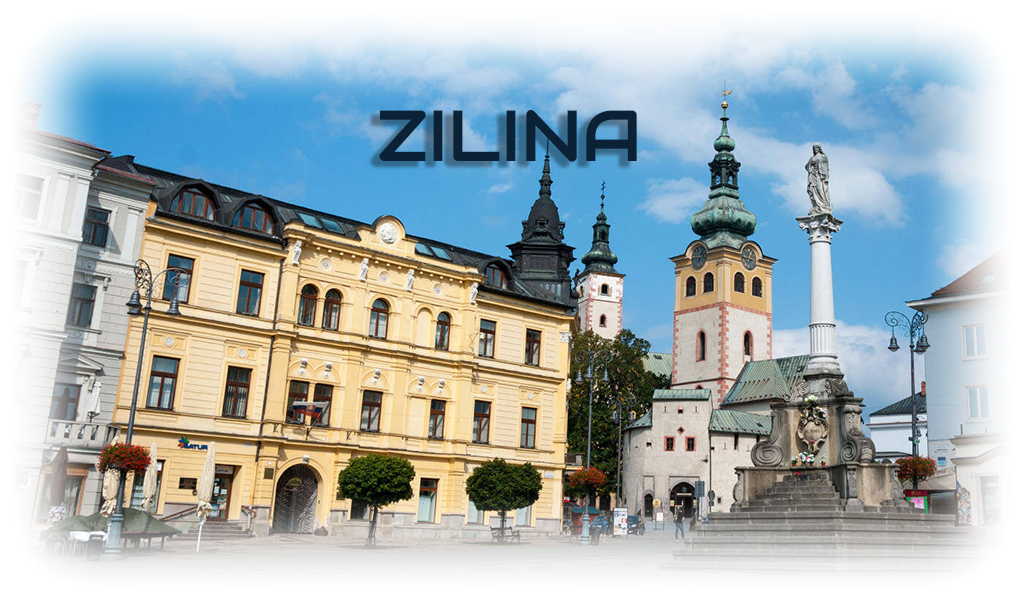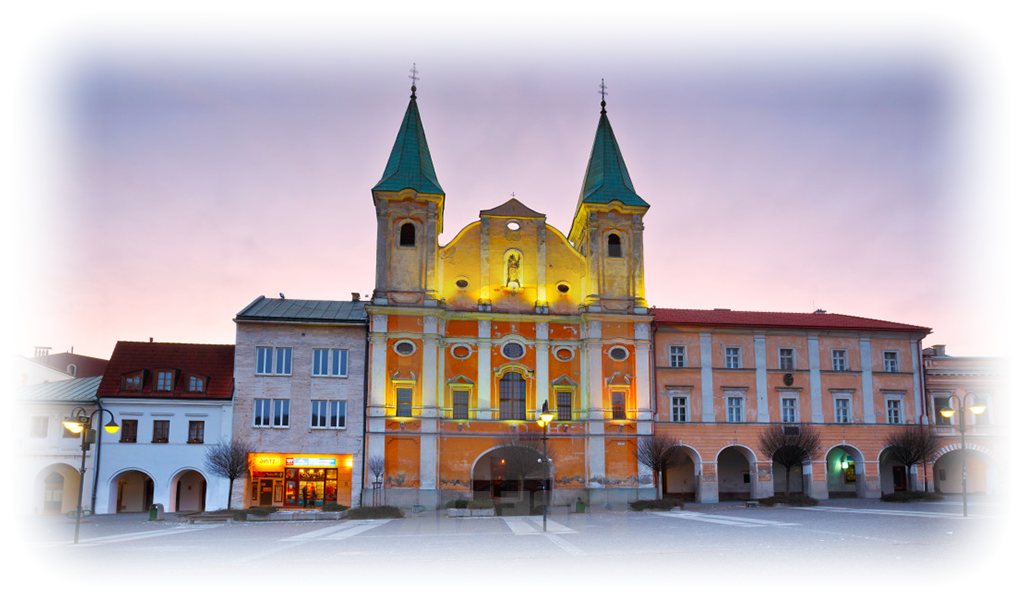
Žilina is one of the most beautiful cities in Slovakia, which "breathes" history. Located in the northwest of the country and is the capital of the eponymous region. Žilina is one of the largest Slovak cities and has an excellent historical center with a significant influence of German architecture. Its heart is the seven-hundred-year-old Marian Square, around which are several ancient monuments. Žilina is one of the fastest growing cities in Slovakia and a major industrial center, which is considered the unofficial capital of its northwest.
Geography and weather
Žilina is located in the northwest of Slovakia at the confluence of three rivers: Vah, Kisucy and Raičanka. The average height above sea level is 342 meters. The city is surrounded by mountain ranges and has a temperate continental climate with warm summers and cool (usually quite snowy) winters.
History and interesting facts
The Slavs settled in the vicinity of Zilina in the 5th century. The settlement on the site of a modern city was founded in the 11th century. Zilina was first mentioned only in 1297 and in 1327 received city rights. In the second half of the 10th century the city became part of the Kingdom of Hungary and remained part of Hungary until 1918. At the end of the 13th century, Žilina burned in a great fire. Later, the city was rebuilt by Saxon colonists, so it has a significant influence of German architecture. In 1431 Žilina was burned by the Hussites.
15th century is the heyday of Zilina as a major trade and craft center. In the 16th and 17th centuries, the city was the center of the Hungarian Reformation. The 18th century seemed dramatic for Zilina. The city suffers from severe fires and epidemics. In the 19th century, its prosperity and prosperity were associated with industrialization. Today Žilina is one of the largest cities in Slovakia, a major industrial, educational and cultural center.
Geography and weather
Žilina is located in the northwest of Slovakia at the confluence of three rivers: Vah, Kisucy and Raičanka. The average height above sea level is 342 meters. The city is surrounded by mountain ranges and has a temperate continental climate with warm summers and cool (usually quite snowy) winters.
History and interesting facts
The Slavs settled in the vicinity of Zilina in the 5th century. The settlement on the site of a modern city was founded in the 11th century. Zilina was first mentioned only in 1297 and in 1327 received city rights. In the second half of the 10th century the city became part of the Kingdom of Hungary and remained part of Hungary until 1918. At the end of the 13th century, Žilina burned in a great fire. Later, the city was rebuilt by Saxon colonists, so it has a significant influence of German architecture. In 1431 Žilina was burned by the Hussites.
15th century is the heyday of Zilina as a major trade and craft center. In the 16th and 17th centuries, the city was the center of the Hungarian Reformation. The 18th century seemed dramatic for Zilina. The city suffers from severe fires and epidemics. In the 19th century, its prosperity and prosperity were associated with industrialization. Today Žilina is one of the largest cities in Slovakia, a major industrial, educational and cultural center.

Attractions
Marian Square(formerly Market Square, Round and Franz Josef Square) is the historic core of Zilina, surrounded by old houses with arcades in the style of German architecture. The area was founded 700 years ago. The first mention of the market here dates back to 1464. Initially, the area was surrounded mainly by wooden houses, which were replaced by stone after a fire in 1521. In the center is a baroque statue of the Virgin Mary of the 18th century.
Church of St. Trinity is the ancient cathedral, which is one of the symbols of Zilina. It was built in the 14th century on the foundations of a medieval castle. In the 16th century, the original Gothic church was rebuilt and received Renaissance architecture. The main altar dates back to the end of the 17th century.
Buriana Tower is a free-standing bell tower of the cathedral, which is one of the oldest Renaissance bell towers in Slovakia. It was built on the model of Italian campaniles in the 16th century and rebuilt in the 18th and 19th centuries. The town hall is a historic building, first mentioned in the early 16th century. This house (with original Gothic cellars) has been renovated many times - from the original Gothic and Renaissance in its current state in the 19th century.
The Town Hall is a historic building, first mentioned in the early 16th century. This house (with original Gothic cellars) has been renovated many times - from the original Gothic and Renaissance in its current state in the 19th century.
The Church of the Holy Apostles Peter and Paul is a Jesuit church in the Baroque style, built in the 18th century on the site of five original Renaissance houses.
The Rosenfeld Palace is a miniature model of the Viennese Belvedere and one of the most beautiful buildings of Zilina in the Art Nouveau style. It dates back to the early 20th century and is a national cultural monument.
Church of St. Barbarians is a Franciscan church built in the first half of the 18th century, which is the first baroque sacred building in Žilina.
Budatin Castle is a remarkable historical monument in the vicinity of Žilina. The beginning of the construction of the stone castle dates back to the second half of the 13th century. Its largest and oldest part is a bulky four-story cylindrical Romanesque tower with elements of early Gothic architecture, which was later rebuilt in the Renaissance style. The modern building stands on the site of the original water castle, which guarded the trade route to Silesia.
Marian Square(formerly Market Square, Round and Franz Josef Square) is the historic core of Zilina, surrounded by old houses with arcades in the style of German architecture. The area was founded 700 years ago. The first mention of the market here dates back to 1464. Initially, the area was surrounded mainly by wooden houses, which were replaced by stone after a fire in 1521. In the center is a baroque statue of the Virgin Mary of the 18th century.
Church of St. Trinity is the ancient cathedral, which is one of the symbols of Zilina. It was built in the 14th century on the foundations of a medieval castle. In the 16th century, the original Gothic church was rebuilt and received Renaissance architecture. The main altar dates back to the end of the 17th century.
Buriana Tower is a free-standing bell tower of the cathedral, which is one of the oldest Renaissance bell towers in Slovakia. It was built on the model of Italian campaniles in the 16th century and rebuilt in the 18th and 19th centuries. The town hall is a historic building, first mentioned in the early 16th century. This house (with original Gothic cellars) has been renovated many times - from the original Gothic and Renaissance in its current state in the 19th century.
The Town Hall is a historic building, first mentioned in the early 16th century. This house (with original Gothic cellars) has been renovated many times - from the original Gothic and Renaissance in its current state in the 19th century.
The Church of the Holy Apostles Peter and Paul is a Jesuit church in the Baroque style, built in the 18th century on the site of five original Renaissance houses.
The Rosenfeld Palace is a miniature model of the Viennese Belvedere and one of the most beautiful buildings of Zilina in the Art Nouveau style. It dates back to the early 20th century and is a national cultural monument.
Church of St. Barbarians is a Franciscan church built in the first half of the 18th century, which is the first baroque sacred building in Žilina.
Budatin Castle is a remarkable historical monument in the vicinity of Žilina. The beginning of the construction of the stone castle dates back to the second half of the 13th century. Its largest and oldest part is a bulky four-story cylindrical Romanesque tower with elements of early Gothic architecture, which was later rebuilt in the Renaissance style. The modern building stands on the site of the original water castle, which guarded the trade route to Silesia.








